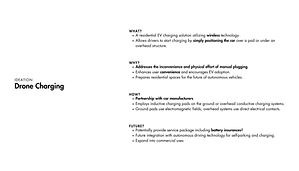
Linki is an autonomous charging bot system designed to deliver power to each parking spot so that every spot becomes a charging spot.
Tools Used:

Research
S T E E P +
Macro Trend Research


Rapid Growth in EV Ownership
The rapid growth in electric vehicle (EV) ownership marks a transformative shift in the automotive sector. As nations worldwide commit to electrification, governmental policies and market dynamics are crucial in accelerating this transition.
Technological Convergence
Technological convergence involves the fusion of diverse technologies into innovative systems that open up new realms of possibilities. As diverse technological systems and their applications increasingly intersect, they catalyze the creation of novel opportunities, driving smarter, more efficient solutions.

As nations worldwide commit to electrification, the dynamics within the automotive market are consequently evolving to accommodate an increasing demand for electrification. This includes not only increasing the number of charging stations but also improving their management systems to ensure that they are available to those who need them when they need them.
Now is the ideal time to leverage cutting-edge technology and unlock new possibilities to address the rising demand for electrification.

Qualitative: hour-long interviews with both EV users and professionals working in the EV industry.
Primary Research
Quantitative: questionnaires
Problems
FOR EV OWNERS




"ICED" EV Spots
You want to charge your car, but all the EV spots are occupied, either by other electric vehicles or by internal combustion engine cars.
Out of Order Chargers
Harvard Business School research indicates that one in five public chargers in the US is out of order, and they often remain not repaired for extended periods.
Idle Fees
If drivers don't move their cars promptly, idle fees begin accruing 5 to 10 minutes after charging is complete.
Time Wasted
Concerned about idle fees, drivers often wait by their cars with their phones, leading to unnecessary time spent waiting.
FOR SYSTEM OPERATORS

Underutilized Chargers Lead to Profit Loss
The problems that users encountered not only frustrates drivers who need to recharge but also results in lost revenue for service providers who cannot utilize their charging stations efficiently.

Heavy Digging Involved During Installation
For businesses, installing traditional chargers often require extensive digging. This can block off multiple parking spots and disrupt regular operations.
How might we develop a scalable and well-designed EV charging solution that optimizes operational efficiency for system operators while enhances convenience for users?
Challenge
Ideation
Charging Methods
Explored various charging methods, evaluate each concept in aspects like viability, difficulty of implementation, and future development, and eventually chose bot charging at it scored the highest overall.






Bot
Bot
Bot
Bot
>>

Station
Bot
Station
Battery Pack

Multiple bots (one for each car)
Reduce manufacturing expenses and expand service coverage
by modularization
One bot
+
Multiple rechargeable battery packs
+
One charging station







_edited.jpg)
Public Parking Structure
Mall/Shopping Center
Stadium
Grocery
Theme Parks
Restaurant
Airport
Apartment Complex


Beachhead Market
Explored various beachhead market options for launching this new charging service. Identified shopping centers as the ideal choice, by using tools like the Business Model Canvas and the Opportunity Attractiveness Scale.
Mood Board

Slender
The design is envisioned with a tall and slender form to ensure visibility and enable smooth navigation in tight parking conditions
Sturdy
Exposed engineering elements keep people aware of operational areas, while a sturdy overall stance conveys reliability and durability.
Sleek
A predominantly white color palette underscores the design’s sleek, modern aesthetic and reflects sunlight to reduce heat buildup in the battery packs.
Form Exploration
AI Brainstorming
MidJourney as a quick brainstorming tool and got some inspiration.




Scale Study
I built a scaled mock-up using cardboard boxes and tested it in parking lots. By recording videos, I analyzed whether it obstructed driveways or interfered with other drivers and pedestrians.
Exploration & Refinement
Explore overall form and experiment with arrangements of key functions.



From Rhino exploration to detailed refinements and precise dimensioning in SolidWorks.






Iterations
3D-printed scaled models to refine the bot's stability. During the iteration process, I increased the width of the bot's base and gave it more robust-looking wheels to enhance its overall stability.
Graphic

Station Layout
To address the issues of underutilization and the extensive digging faced by system operators, I designed the station dimensions based on the U.S. standard parking spaces. This solution allows businesses to strategically choose locations closest to the grid for station installation, reducing disruption, conserving parking space, and simplifying installation.








System Map
Final Design

Linki Bot

Hardware: One (1) Linki Bot + Eight (8) Battery Packs + One (1) Station + Eight (8) Charging Poles
Software: Linki App
Battery Pack
Station
Linki Bot
Charging Pole
Standard Linki Unit:

Dimension
Prototyping
I 3D-printed all the components, then sanded, spray-painted, and assembled them to create the 1:4 model.








Key Features

Simple ordering on the Linki App

Robot Arm Connects with the Plug

Linki Bot Releases the Battery Pack

Linki Bot Stops for Pedestrian

Linki Bot and Battery Pack Charges at the Station













